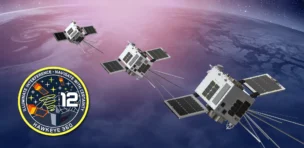Six companies received a combined $1.9M in contracts from the Space Development Agency to conduct feasibility studies on space deorbit services, the organization announced Thursday.
The organization plans to deploy hundreds of space vehicles in LEO as part of the SDA’s Proliferated Warfighter Space Architecture (PWSA). While these vehicles will have onboard propulsion systems to conduct end-of-life maneuvers, the studies are meant to explore redundant, cost-effective contingency options for future satellite disposal, an SDA spokesperson told Payload.
Arkisys, Impulse Space, Quantum Space, Sierra Space, SpaceWorks Enterprises, and Starfish Space will conduct the studies this year.
Been there, done that: In a few cases, these studies will be built on the dynamic on-orbit capabilities the companies have already demonstrated.
- Starfish proved its budding expertise in conducting rendezvous and proximity operations (RPO) when its Otter Pup spacecraft came close enough to photograph D-Orbit’s ION satellite this spring. In its SDA study, the company will attempt to show how Otter’s capabilities extend beyond simple deorbit functions, cofounder Trevor Bennett told Payload.
- Impulse Space launched its first spacecraft, Mira, at the end of last year, and successfully raised its apogee by 150 km, which the company believes to be one of the largest orbital maneuvers by a nitrous-based system. Impulse president and COO Eric Romo told Payload that the high thrust capabilities make it a strong solution for the SDA, and future missions launching next year will take place on an upgraded version of the Mira.
Wait and see: For other companies, the study will be a look at what we can expect from inaugural missions.
- Sierra Space will base its study on its Spectre spacecraft, expected to launch at the end of next year.
“The Spectre mission is an internally-funded mission to prove out robotic inspection, capture, and servicing in low-Earth orbit,” Sierra Space business development manager, Joe Calibeo told Payload. “We anticipate significant overlap from the Spectre mission… and a hypothetical deorbit as a service offering.”
- For Arkisys, the study presents an opportunity to display a more nuanced, holistic solution. The company’s idea is to build a commercial port on orbit, aptly named The Port, where satellites can dock for servicing, take on cargo, and undergo assembly and modifications.
Arkisys will also have “Cutter” vehicles that will act like in-space tugboats to assist with the RPO maneuvers, the first of which is planned to launch next year. For the SDA study, the hope is to demonstrate how these vehicles could deploy from Port to rapidly assist the SDA when needed.
“My hope is that we can show that this has significant value that goes well above and beyond just deorbiting a satellite,” Arkisys CEO Dave Barnhart told Payload.




